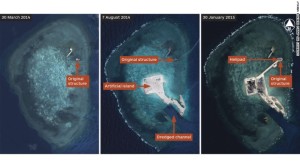By: Timothy Aderman
In a highly aggressive move, China’s military stated through a news outlet that tension in the South China Sea may inevitably lead to conflict with the U.S. While neither side wants this statement to be brought to fruition, considering recent activities, armed conflict is neither unlikely nor unforeseeable.
While the U.S. and its regional allies, Vietnam and the Philippines, consider the bulk of the South China Sea to be international waters, China has laid claim to over 90% of the Sea. Since this expansion of perceived territory, U.S. military flights, including surveillance flights that once flew over international waters are now considered to be provocatively probing into Chinese airspace. The U.S. has responded by saying they only patrol international waters and airspace and do not intrude upon Chinese territory.
Portions of the Sea have been claimed by China in the context of providing ecological sustainability. However, laying claim to international waters effectively contravenes international laws governing major shipping lanes. Many believe China’s decision to expand its territory is to further its economic growth and demonstrate military dominance.
A myriad of conflicts in the South China Sea have heightened tension. China recently ordered a fishing ban that applied to Vietnamese fishing boats in the Gulf of Tonkin. This ban has provoked Vietnam and a war of words is ensuing.
Taking a play out of a James Bond villain’s playbook, China has also constructed a series of artificial islands in the South China Sea’s Spratly Islands. An operational helipad sits on the north eastern section of the island while Satellite imagery shows a nearly completed airstrip. This base, once fully operational, will allow China to project its military might over a much larger swath of the South China Sea.
China is also expanding its naval force. In a high-profile move, China acquired an older aircraft carrier from Russia and renamed it the Liaoning. The Liaoning, with its upward sloping flight deck, was commissioned in 2012. This addition to the PLA (People’s Liberation Army) Navy greatly expands the theoretical range of China’s projection. It is unknown as to what stage the Liaoning is operational including its effective range.
Alongside an increase of submarines, this expansion of deep water vessels occurs at the same time the U.S. has been investing in littoral, or near-to-shore, vessels.
The U.S. could be dragged into conflict with China by direct action between Chinese and U.S. naval vessels. This dramatic showdown would cause an extreme shift of U.S. resources from the Middle East to be redirected into the Pacific region.
Alternatively, as China continues to push its neighbor’s buttons, the U.S. may be brought into conflict through supporting one of its regional allies, particularly Vietnam and the Philippines. A confrontation between Vietnam and China or, alternatively, with the Philippines would necessitate U.S. support.
Photo: CNN

